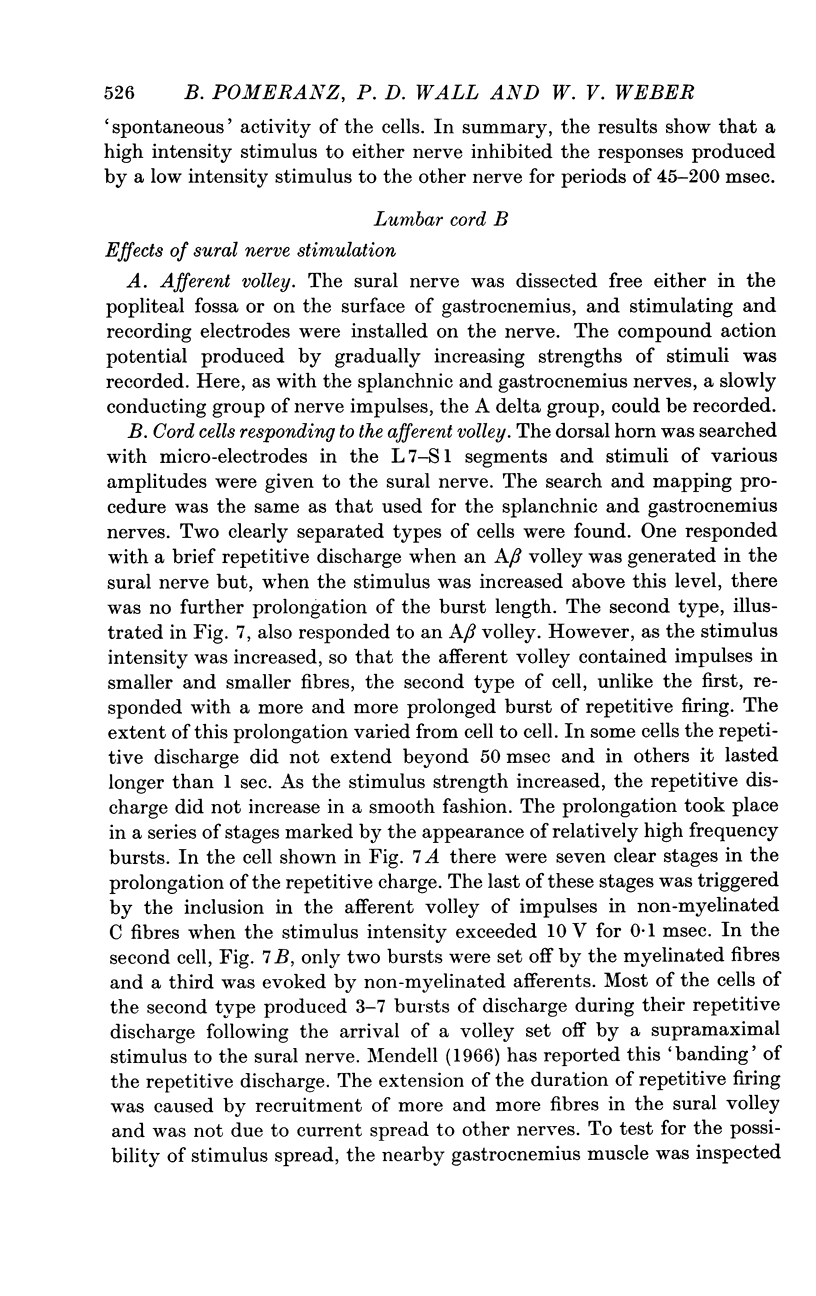Abstract
1. Micro-electrode recordings were made in the thoracic cord of acute spinal cats. Cells, which were located in the histologically defined lamina 5, responded both to the fine myelinated afferents from the splanchnic nerve and to afferents from the skin. Splanchnic afferents inhibit the effect of converging cutaneous inputs for periods up to 150 msec. Skin stimuli may also inhibit the effect of afferent nerve impulses from viscera. Some cells respond monosynaptically to the splanchnic afferents, others indirectly.
2. Fine myelinated afferents from gastrocnemius (group 3) stimulate lamina 5 cells which also have cutaneous receptive fields. Cutaneous and group 3 muscle afferents interact by mutual inhibition in their effect on the cells.
3. Fine myelinated afferents from skin excite lamina 5 cells. The cutaneous responses of lamina 5 cells contrast with those of lamina 4 cells in the following respects: (a) the receptive fields are larger, (b) they respond with an increased latency to Aβ afferents, (c) there is a low pressure threshold at the edge, (d) they respond to a wide range of pressure stimuli from light brush to heavy pinch applied to the centre of the receptive fields and (e) they respond to AΔ afferents.
4. Lamina 5 cells receive fine myelinated afferents either from viscera or from muscle or from skin. Lamina 4 receives large myelinated afferents from skin and lamina 6 receives large myelinated afferents from muscle. The results suggest the hypothesis that some fine myelinated afferents form a class of afferents which signal the state of tissue, and end on lamina 5 cells.
Full text
PDF





















Selected References
These references are in PubMed. This may not be the complete list of references from this article.
- Bessou P., Perl E. R. Amovement receptor of the small intestine. J Physiol. 1966 Jan;182(2):404–426. doi: 10.1113/jphysiol.1966.sp007829. [DOI] [PMC free article] [PubMed] [Google Scholar]
- DOWNMAN C. B. Skeletal muscle reflexes of splanchnic and intercostal nerve origin in acute spinal and decerebrate cats. J Neurophysiol. 1955 May;18(3):217–235. doi: 10.1152/jn.1955.18.3.217. [DOI] [PubMed] [Google Scholar]
- Fetz E. E. Pyramidal tract effects on interneurons in the cat lumbar dorsal horn. J Neurophysiol. 1968 Jan;31(1):69–80. doi: 10.1152/jn.1968.31.1.69. [DOI] [PubMed] [Google Scholar]
- Franz D. N., Evans M. H., Perl E. R. Characteristics of viscerosympathetic reflexes in the spinal cat. Am J Physiol. 1966 Dec;211(6):1292–1298. doi: 10.1152/ajplegacy.1966.211.6.1292. [DOI] [PubMed] [Google Scholar]
- HUNT C. C., McINTYRE A. K. An analysis of fibre diameter and receptor characteristics of myelinated cutaneous afferent fibres in cat. J Physiol. 1960 Aug;153:99–112. doi: 10.1113/jphysiol.1960.sp006521. [DOI] [PMC free article] [PubMed] [Google Scholar]
- LUNDBERG A., OSCARSSON O. Three ascending spinal pathways in the dorsal part of the lateral funiculus. Acta Physiol Scand. 1961 Jan;51:1–16. doi: 10.1111/j.1748-1716.1961.tb02108.x. [DOI] [PubMed] [Google Scholar]
- LUNDBERG A. SUPRASPINAL CONTROL OF TRANSMISSION IN REFLEX PATHS TO MOTONEURONES AND PRIMARY AFFERENTS. Prog Brain Res. 1964;12:197–221. doi: 10.1016/s0079-6123(08)60624-x. [DOI] [PubMed] [Google Scholar]
- Mendell L. M. Physiological properties of unmyelinated fiber projection to the spinal cord. Exp Neurol. 1966 Nov;16(3):316–332. doi: 10.1016/0014-4886(66)90068-9. [DOI] [PubMed] [Google Scholar]
- PAINTAL A. S. Functional analysis of group III afferent fibres of mammalian muscles. J Physiol. 1960 Jul;152:250–270. doi: 10.1113/jphysiol.1960.sp006486. [DOI] [PMC free article] [PubMed] [Google Scholar]
- WALL P. D. Cord cells responding to touch, damage, and temperature of skin. J Neurophysiol. 1960 Mar;23:197–210. doi: 10.1152/jn.1960.23.2.197. [DOI] [PubMed] [Google Scholar]
- WIDEN L. Cerebellar representation of high threshold afferents in the splanchnic nerve with observations on the cerebellar projection of high threshold somatic afferent fibres. Acta Physiol Scand Suppl. 1955;33(117):1–69. [PubMed] [Google Scholar]
- Wall P. D., Freeman J., Major D. Dorsal horn cells in spinal and in freely moving rats. Exp Neurol. 1967 Dec;19(4):519–529. doi: 10.1016/0014-4886(67)90172-0. [DOI] [PubMed] [Google Scholar]
- Wall P. D. The laminar organization of dorsal horn and effects of descending impulses. J Physiol. 1967 Feb;188(3):403–423. doi: 10.1113/jphysiol.1967.sp008146. [DOI] [PMC free article] [PubMed] [Google Scholar]
- Wickelgren B. G. Habituation of spinal interneurons. J Neurophysiol. 1967 Nov;30(6):1424–1438. doi: 10.1152/jn.1967.30.6.1424. [DOI] [PubMed] [Google Scholar]


